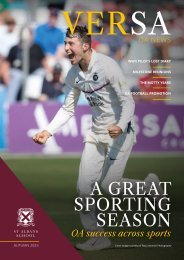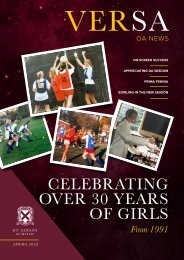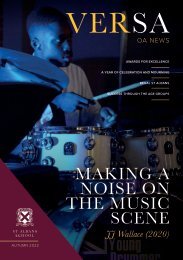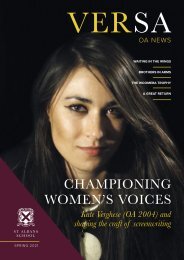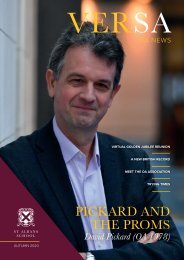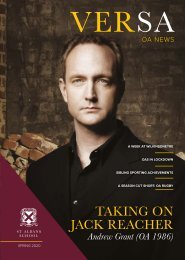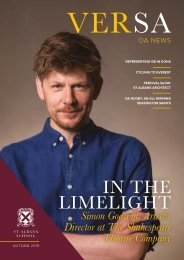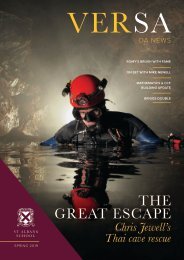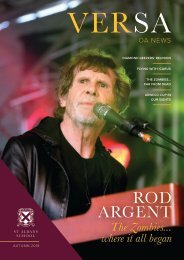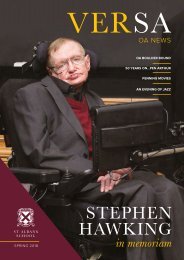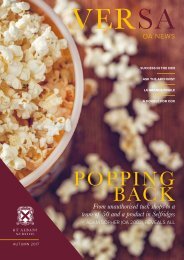Versa: Issue Ten
Versa is a biannual publication and will be published every autumn and spring term. Versa has replaced the former magazine, OA Bulletin and will offer a comprehensive insight into the many facets of alumni life.
Versa is a biannual publication and will be published every autumn and spring term. Versa has replaced the former magazine, OA Bulletin and will offer a comprehensive insight into the many facets of alumni life.
Create successful ePaper yourself
Turn your PDF publications into a flip-book with our unique Google optimized e-Paper software.
12<br />
13<br />
ASK THE ARCHIVIST<br />
THE HIGHT COURT<br />
DEBT 1722<br />
Part One<br />
By Sue Gregory, School Archivist, and Lower Sixth Pupils Ioan and Matthew<br />
In 1722, John Fothergill, Headmaster of St Albans School, found himself<br />
in the untenable position of having to take the Mayor and the St Albans<br />
Corporation (communality) to the High Court for non-payment of his salary…<br />
For over ten years, Fothergill found that his salary of<br />
£50 was repeatedly cut and the debt the corporation<br />
owed him was never fully repaid or an excuse of<br />
repairs to the School was used in order to prolong the nonpayment.<br />
Fothergill’s action uncovered a ‘Pandora’s box’<br />
of misappropriation of funds where both the School and<br />
Fothergill were paying for events, activities and so called<br />
‘parliamentary causes’ dating from the mid-17th century<br />
to the early 18th century. On 13th May 1722, The Court<br />
of Chancery (High Court) found that 72 years of debt<br />
equating to £161.2.3 was owed by the Mayor and St Albans<br />
Corporation to the School; a 6% interest was levied making a<br />
total of £1029.12.9 1 . Also from ‘the sayd inquisition’ Fothergill<br />
was owed £271.1.2 (in 2021 this figure would be £63,810.33) 2 .<br />
To mark the 300th anniversary of this court action, the<br />
Museum and Archive Sixth Form study group have begun<br />
looking closely at the historic records held within the St<br />
Albans School Archive. By researching the individuals<br />
involved and the St Albans community at this time, the pupils<br />
found an increase in social mobility and trading within<br />
St Albans. In this short piece we will reveal some of their<br />
findings…<br />
“By researching the individuals<br />
involved and the St Albans<br />
community at this time, the pupils<br />
found an increase in social mobility<br />
and trading within St Albans”<br />
John Fothergill, a Cambridge scholar whose Under<br />
Master whilst at Cambridge was James Shirley, former<br />
Headmaster at St Albans School from 1619-1624, appears<br />
to have studied ‘sciences and astronomy’. Fothergill was an<br />
assistant to The Cambridge Platonists (these were a group of<br />
clergymen associated with Emmanuel and Christ’s Colleges<br />
in Cambridge, who called for a renewal of interest in the<br />
philosophy of Plato) 3 , and with such connections, becoming<br />
Headmaster at St Albans School was a certainty. During his<br />
time as Headmaster he managed to lead a fairly prosperous<br />
School, maintaining an entry of ten or eleven boys a year<br />
as well as increasing the School’s library from 113 books to<br />
nearly 200 volumes 4 . Fothergill was helped financially by<br />
legacies made by Thomas Lathbury, who was a scholar of St<br />
Albans School. His father, also called Thomas, was a special<br />
advisor to Elizabeth, Countess of Oxford, the daughter of<br />
Edward Trussell, who was heiress to all her father’s estates in<br />
Warwickshire. Thomas Lathbury senior’s business acumen<br />
helped the Countess to preserve her estates despite threats of<br />
abduction and theft, and to increase her lands; her will and<br />
probate of 1527 saw Lathbury senior gifted significant land<br />
in Bedfordshire, and the right to trade spices and “special<br />
minerals” in St Albans. (St Albans was at this time a major<br />
trading location for “The Silk Route” from Persia). Thomas<br />
Lathbury Junior continued his father’s business and in his<br />
will of 1579 set up a charity to house the poor in St Albans<br />
(this charity still exists today). The 1722 High Court action<br />
found that money gifted from this charity was not used<br />
for the poor but was used by the corporation to entertain<br />
visitors. The Court ruled ‘…this lawful directive amounts to<br />
£386 (£90,097.14 in 2021) with interest, the sum is £990.0.14<br />
(£231,078.16 in 2021) to be payable back to the poor fund<br />
from 25th day of our Lady (March) 1723 to Alms houses<br />
on St Peter’s St’ 5 . The Lathbury Trust also paid for scholarly<br />
places at St Albans School and was a regular benefactor of<br />
scholarly books from the ‘Arabian World’ 6 . The Lathburys<br />
built significant property and owned many inns within St<br />
Albans, and as such, financially supported apprenticeships to<br />
the building trade.<br />
One significant benefactor of such a legacy was John Carter,<br />
a carpenter who undertook a 15 year apprenticeship to the<br />
Lathburys. Carter was a successful carpenter and plumber<br />
who worked and resided at 15 A & B George Street, St Albans<br />
during the 17th century. Records indicate his success as a<br />
businessman and craftsmen; his will, written in 1674, showed<br />
that he owned two properties at the time of his death and<br />
had significant funds. 7 This was unusual for the trade of a<br />
carpenter, and showed that his business prowess and literacy<br />
were more than that of a carpenter. It is believed that these<br />
skills were taught to him whist attending St Albans School.<br />
A prominent member of the St Albans community, Carter<br />
was also a member of the corporation (council) of St Albans,<br />
which led to his involvement in the case surrounding the<br />
School. Initially, John Carter benefitted from low taxes<br />
on wood imports, which allowed him to draw large profit<br />
margins. Indeed, an inventory of his assets shows that<br />
Carter’s properties were equipped with newly designed and<br />
expensive furnishings, indicating his lavish spending as a<br />
result of his success. 8 However, the customs act in 1660<br />
introduced far heavier taxes on imported wood, affecting<br />
Carter’s trade and profits. Incensed, Carter sought revenge.<br />
One key figure involved in the passing of the Customs Act<br />
was Thomas Lathbury. In retaliation against Lathbury,<br />
therefore, Carter suggested that the corporation reinstated<br />
rent charges against the School. This proposal was taken<br />
up, meaning that despite no rents having been collected for<br />
300 years previously, the School was made to pay from 1697<br />
to 1722. However, in 1723 the High Court judged that the<br />
School had wrongfully been made to pay rent without due<br />
cause. 9<br />
This research shows that the High Court action exposed long<br />
standing charges, debts and miss appropriation of funds, but<br />
more interestingly, that social mobility through education<br />
was a key success for individuals at the time. In Part Two,<br />
to be published in <strong>Issue</strong> 11 of <strong>Versa</strong>, we will tell of the High<br />
Court ruling, detailing more of the individuals who were<br />
involved in this case.<br />
1 Order on hearing Excons for the Decree of Com’ of charitable use of the mayor and commonality of St Albans con<br />
Fothergill, St Albans School Archive, 1722-1724, pg43<br />
2 Order on hearing Excons for the Decree of Com’ of charitable use of the mayor and commonality of St Albans con<br />
Fothergill, St Albans School Archive, 1722-1724, pg45<br />
3 Goldie M (2005) Oxford Dictionary of National Biography, referenced 22/4/22<br />
4 Kilvington F, (1970) A Short History of St Albans School, Staples Printers Ltd, London, pg 26 & St Albans School<br />
Account ledger dated 1600-1800<br />
5 Order on hearing Excons for the Decree of Com’ of charitable use of the mayor and commonality of St Albans con<br />
Fothergill, St Albans School Archive, 1722-1724, pg113<br />
6 St Albans School Account ledger dated 1600-1800<br />
7 John Carter 1662 PROB/5117, The National Archives<br />
8 Will of Robert Graves HALS 9AR151 and Will of John Carter 1662 PROB/5117<br />
9 Order on hearing Excons for the Decree of Com’ of charitable use of the mayor and commonality of St Albans con<br />
Fothergill, St Albans School Archive, 1722-1724, pg195




